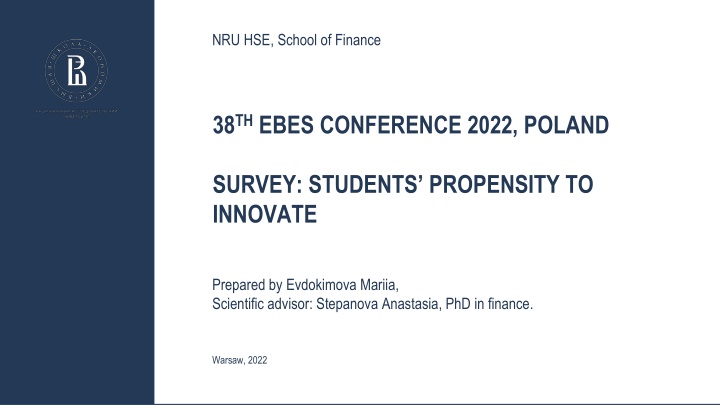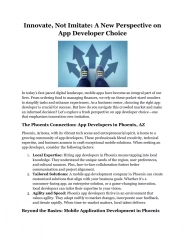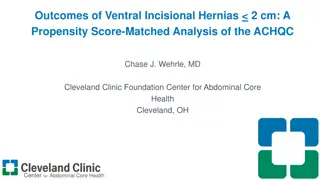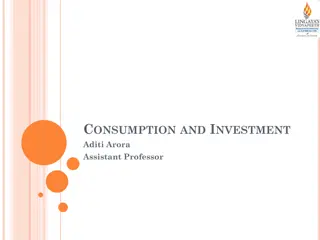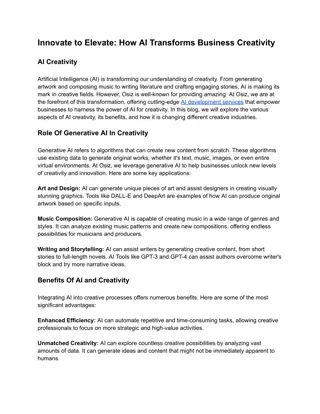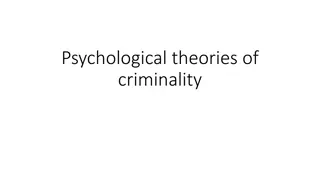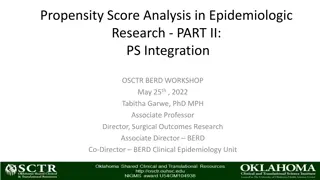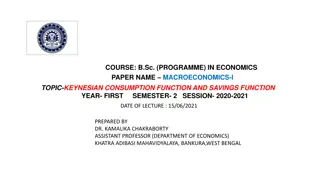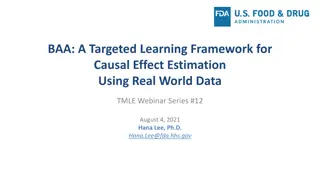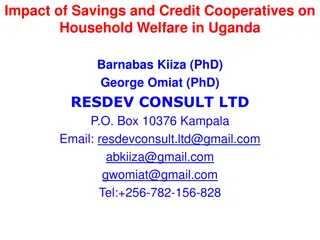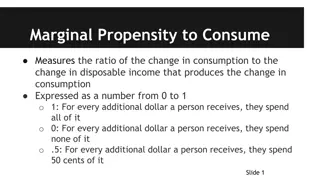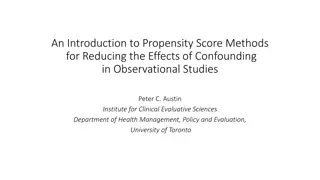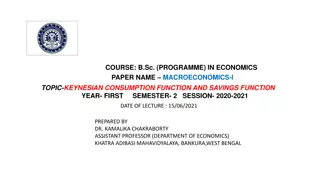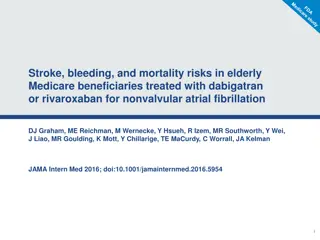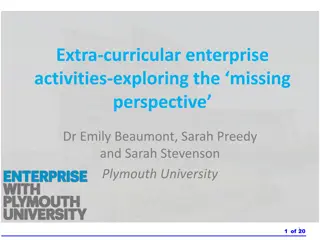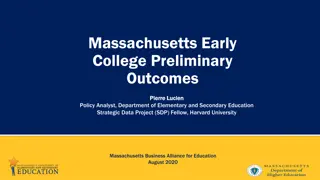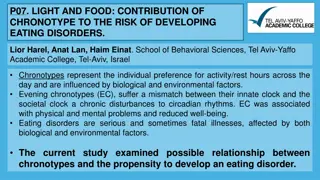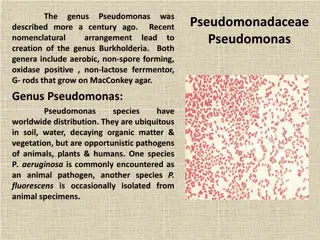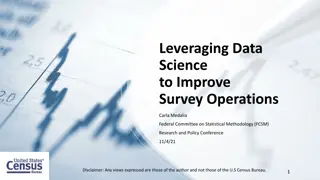Students' Propensity to Innovate Study
Delve into the individual propensity to innovate (PtI) at the 38th EBES Conference in Poland. Explore innovative performance factors, including risk-attitude and proactivity, through an analysis of survey results and correlation matrices. Understand the relevance of this research in the context of macroeconomics roots and market inefficiency. Gain insights into PtI's determinants and the innovation creation process at the individual level.
Download Presentation

Please find below an Image/Link to download the presentation.
The content on the website is provided AS IS for your information and personal use only. It may not be sold, licensed, or shared on other websites without obtaining consent from the author.If you encounter any issues during the download, it is possible that the publisher has removed the file from their server.
You are allowed to download the files provided on this website for personal or commercial use, subject to the condition that they are used lawfully. All files are the property of their respective owners.
The content on the website is provided AS IS for your information and personal use only. It may not be sold, licensed, or shared on other websites without obtaining consent from the author.
E N D
Presentation Transcript
NRU HSE, School of Finance 38THEBES CONFERENCE 2022, POLAND SURVEY: STUDENTS PROPENSITY TO INNOVATE Prepared by Evdokimova Mariia, Scientific advisor: Stepanova Anastasia, PhD in finance. Warsaw, 2022
AGENDA 38thEBES Conference, Poland Relevance of the research Propensity to innovate Sensation seeking Creativity Innovative performance: risk-attitude and proactivity Hypotheses Data gathering Survey results Correlation matrices Propensity to innovate analysis Risk-attitude analysis Conclusion 2
RELEVANCE OF THE RESEARCH 38thEBES Conference, Poland Cumulative citations in Scopus Macroeconomics roots ? = ?(?,?,?&?,??) [Romer, 1986] Market inefficiency [De Bondt et al., 1985; Roll 1984; Stein, 1989] Microeconomics roots 30,000.00 Innovations value relevance Irrationality proof Schumpeter (1911) 25,000.00 Prospect theory (Tversky & Kahneman, 1979) 20,000.00 Citations 15,000.00 10,000.00 Since [Johannessen & Olsen, 2010] In 2021 4/10 the most profitable companies in the world are IT companies 1990-s moving to knowledge based economy 5,000.00 0.00 <2016 2016 2017 2018 2019 2020 CEO & innovations Board & innovations CEO & board & innovations Objectives of the study: To analyze innovation creation process at the individual level; To identify individual propensity to innovate (PtI) and its determinants; To prepare and conduct a survey measuring PtI and its determinants; The object of the research is innovations creation. The subject of the research is individual propensity to innovate. The goal: to estimate the individual propensity to innovate and reveal its determinants. 3
PROPENSITY TO INNOVATE 38thEBES Conference, Poland Individual innovation creation process Individual propensity to innovate (PtI) - to what Motive Prerequisites Innovative performance extent person is able to create innovation? [0, 9] in accordance with AltKirt Sensation seeking [Zuckerman, 1994] Creativity: risk-taking, and knowledge [Yagolkovskiy, 2019] Proactivity, risk [Hormiga et al., 2013; McGurik et al., 2015] We re going to measure PtI in dependence on innovation creation process steps Students survey Alternative Kirtman Adoption Inventory (Altkirt) [Bobic et al. (1999)] A Thinking characterized by precision, reliability, efficiency, prudence, discipline Thinking characterized by lack of discipline, linking of unrelated ideas, unusual thought patterns D Solutions sought by tried and true methods Use unproven ideas in seeking solution G type Impractical, unpredictable, change-oriented Practical, predictable, take-care-of-business type E of work Can maintain high accuracy for long periods Work best for short bursts of high intensity H Command of specialized knowledge Command of general knowledge B Interested in finding problems to solve Interested in solving problems F the rest Bending the rules for one person is unfair to I people are involved and probably should be consulted When involved in a project, I am still considerable of others When involved in a project, I forget that other C If rules don t fit, behind them a bit Prefer to work within established rules Bending bureaucracy human the rules if necessary makes 4
SENSATION SEEKING 38thEBES Conference, Poland Definitions: BSSS [Hoyle et al. (2002)]: . . . a trait defined by the seeking of varied, novel, complex, and intense sensations and experiences, and the willingness to take physical, social, legal, and financial risks for the sake of such experience (Zuckerman, 1994) 1. I would like to explore strange places. 2. I get restless when I spend too much time at home. 3. I like to do frightening things. 4. I like wild parties. Schweizer (2006) used the term novelty seeking based on information that novelty-seeking genes gens were found: DRD4, DRD2-A2, SLC6A3- 9 [Benjamin et al. (1996), Ebstein et al. (1996), Prolo and Licinio (2002)]. Novelty seeking is often considered as a concept relevant to the need to seek out new information, and to exploratory activity in response to novel stimulation [Cloninger et al. (1994)]. 5. I would like to take off on a trip with no pre-planned routes. 6. I prefer friends who are excitingly unpredictable. 7. I would like to try bungee jumping. 8. I would love to have new and exciting experiences, even if they are illegal. Measurement Zuckerman, 1979 suggested Sensation-Seeking Scale (SSS) contains 40 self-estimate questions in 10-item scale which may be structured in 4 big seeking groups: Thrill and Adventure Seeking, Experience Seeking, Disinhibition and Boredom Susceptibility. Thrill and Adventure Seeking (TAS), and it contained items expressing a desire to engage in sports or other activities involving speed or danger. Experience Seeking (ES), and it represented the seeking of experience through the mind and senses, travel, and a nonconforming life-style. Disinhibition (Dis), which seemed to represent the desire for social and sexual disinhibition as expressed in social drinking, partying, and variety in sexual partners. Boredom Susceptibility (BS), represented an aversion to repetition, routine, and dull people, and restlessness when things are unchanging. 5
CREATIVITY 38thEBES Conference, Poland Definitions: Creativity tests: Bringing something into being that is original (new, unusual, novel, unexpected) Test and author 1 Remove association test (RAT) by Mednick (1962) and also Valuable (useful, good, adaptive, appropriate) [Ochse (1990)]; Creative thought or behavior must be both novel-original and useful- 2 Guilford s Alternate Uses test [Guilford (1950)] adaptive [Feist (1998)]; 3 Torrance test of creative thinking [Torrance (1972)] ... creativity must entail the following two separate components. First, a creative idea or product must be original... However, to provide a meaningful criterion, 4 Johnson s test [Runco & Johnson (2002)] Picturesque test of creative thinking by Urban & Jellen originality must be defined with respect to a particular sociocultural group. What 5 (2005) may be original with respect to one culture may be old news to the members of 6 Emotional creativity tests [Averill (1999)] some other culture... Second, the original idea or product must prove adaptive in The Creative Achievement Questionnaire (CAQ) [Carson some sense. The exact nature of this criterion depends on the type of creativity 7 et al. (2005)] being displayed [Simonton (1999)]; The Creative Behavior Inventory developed by Hocever Creativity is the ability to produce work that is both novel (i.e., original, 8 (1979) unexpected) and appropriate (i.e., useful, adaptive concerning task constraints) 9 The Creative Achievement Scale [Ludwig (1992)] [Sternberg & Lubart (1999)]; The Biographical Inventory of Creative Behaviours Creativity is the interaction among aptitude, process, and the environment by 10 (BICB) [Furnham et al. (2008)] which an individual or group produces a perceptible product that is both novel and useful as defined within a social context. [Plucker et al. (2004)]; 6
CREATIVITY MEASUREMENT 38thEBES Conference, Poland Torrance s test: Johnson s questionnaire: CAQ: Activity 1. Feel the subtle, vague, and complex features of the world Never Rare Sometimes Often Always around you. Painting, 2. Put forward and express a large number of different ideas. sculpture Music Dance Dizain, hand 3. Suggest different types and categories of ideas. 4. Suggest additional details, ideas, versions or solutions. 5. Show imagination, a sense of humor and develop hypothetical capabilities. craft Writing Theater, film Other: 6. Demonstrate behavior that is unexpected, original, but useful in solving a problem. 7. Refrain from taking the first, typical, generally accepted position that comes to mind and put forward different Mednick s test: There is a triple of words for which you need to find another ideas and choose the best. 8. Show confidence in your decision, despite the difficulties word so that it is combined with each of the three suggested that have arisen; take responsibility for a non-standard words. Example: clock, violin, unity position, an opinion that contributes to solving the Answer: master (watch master, violin master, unique master) problem. 7
INNOVATIVE PERFORMANCE 38thEBES Conference, Poland Risk-attitude Proactivity Gneezy & Potters (1997) Suppose you have 1,000 rubles at your disposal, and you are asked Schweizer (2006) highlighted the main determinants of innovative performance: achievements need, self- to choose which part of a thousand rubles you will invest. The proactivity, confidence, perseverance, assertiveness, investment will either generate an income 2.5 times higher than the extraversion, and cooperativeness original investment or zero income. How much are you willing to invest? Eckel & Grossman (2002) Kahneman, Tversky (1984) Choices, Values, and Frames Choice (50/50 Low payoff, rub. High payoff, rub. Gamble) Gamble 1 Gamble 2 Gamble 3 Gamble 4 Gamble 5 Gamble 6 Hypothesis: Willingness to receive under risk is higher than (Probability = 50%) 280 240 200 160 120 (Probability = 50%) 280 360 440 520 600 700 20 willingness to invest under risk. 8
HYPOTHESES 38thEBES Conference, Poland PtI SS Risk-attitude Source H1 H2 Schweizer (2006), Zuckerman (1994) Schweizer (2006), Yagolkovskiy (2019) Schweizer (2006), Loch (2017) and Shen et al. (2018) Schweizer (2006) Brooks et al. (2018); Guenzel & Malmendier (2020); Serfling (2014) Adams & Ragunathan (2017); Charness et al. (2013); Rossi et al. (2017) Hubar et al. (2020) Roussanov & Savor (2014) Ngan-ling Chow & Zhao (1996) Bernile et al. (2017) Creativity H3 Risk-attitude H4 Proactivity H5 Age H6 Male H7 H8 H9 H10 Income Partner Big family experience Disaster Education (field, level and number of Universities) Working experience Investing experience Entrepreneurship Extreme Sports H11 Allemand et al. (2017) H12 H13 H14 H15 Allemand et al. (2017) Figner & Weber (2011) Hormiga et al. (2013); McGuirk et al. (2015) Brymer (2010) 9
DATA GATHERING 38thEBES Conference, Poland NRU HSE economics students and recent graduates (< 3 years) 153 respondents from 650, response rate is 23% Wave Date 24-25 Sepgraduates Respondents ResponsesAudience Respponse Format Comment 20 20 100,0% 2 20 10,0% 20 20 100,0% 10 58 17,2% 1 215 0,5% 7 234 3,0% 72 78 92,3% 5 9 55,6% 18 26 69,2% 155 680 22,8% Announcement individual message chat announcement announcement chat chat announcement announcement online online offline online online online online online online no motivation no motivation no motivation no motivation no motivation no motivation motivation motivation week motivation announcement wave 0 2 + 3 bac stat 3 bac econom 2 bac econom PhD 2-3 bac econom 4 bac 3 bac stat 2 + 3 bac stat wave 1 wave 2 12 Oct 29 Oct wave 3 1 Nov wave 4 11-16 Nov Response rate in dependence on addressing Response rate in dependence on motivation Individual message Score motivation Week motivation No motivation Average 55% 100% 21% 6% Wave wave 0 (Sep 21) wave 1 (Oct 21) offline wave 2 (Oct 21) ann. wave 3 (Nov 21) chat wave 4 (Nov 21) motive Average AnnouncementChat Average Wave wave 0 (Sep 21) wave 1 (Oct 21) offline wave 2 (Oct 21) ann. wave 3 (Nov 21) chat wave 4 (Nov 21) motive Average 10% 100% 55% 100% 21% 6% 84% 55% 55% 100% 21% 6% 84% 55% 100% 21% 6% 84% 72% 87% 87% 69% 69% 7% 100% 34% 10
SURVEY RESULTS 38thEBES Conference, Poland Descriptive statistics Obs Mean 153 3,6 153 31,7 152 642,6 153 3,7 153 2,1 20 28,8 132 8,3 19 9,9 105 6,6 153 21,1 152 0,6 153 2,2 153 0,9 153 0,6 153 3,8 153 1,2 153 1,5 153 2,6 153 0,64 153 0,5 153 0,3 PtI distribution Variable PtI BSSS RT_inv RT_recive RT_self Johnson CAQ Torrance Mednick Age Male Income Student Working Educ_years N_higher_educ N_jobs Activity Investment Extreme Addicted Std. Dev. 1,9 9,9 295,2 1,3 0,4 4,0 4,3 4,6 1,7 2,2 0,5 2,0 0,3 0,5 1,1 0,5 1,2 0,8 0 0,5 0,5 Min 0,0 9,0 0,0 1,0 1,0 21,0 0,0 2,0 0,0 18,0 0,0 0,0 0,0 0,0 2,0 0,0 0,0 1,0 0 0,0 0,0 Max 9,0 56,0 1000,0 6,0 3,0 36,0 22,0 19,0 10,0 28,0 1,0 6,0 1,0 1,0 9,0 3,0 5,0 4,0 1 1,0 1,0 40 30 20 10 0 0 1 2 3 4 5 6 7 8 9 BSSS distribution 10 8 6 4 2 0 9 14 17 19 21 23 25 27 29 31 33 35 37 39 41 43 45 47 49 51 53 11
SURVEY RESULTS 38thEBES Conference, Poland Risk taking to receive Comparison of risk-attitude estimation methods 6 50 30.0% 5 45 25.0% 1000 40 Expected return ,% 900 4 35 20.0% 800 30 700 15.0% 600 25 3 500 20 10.0% 400 15 300 2 5.0% 10 200 100 5 0.0% 1 0% 12% 24% 35% 45% 56% 65% 74% 83% 92% 100% Standard deviation, % 0 0 1 2 3 4 5 6 Risk taking to invest invest receive 60 SHARE OF WORKING STUDENTS Not working 50 GENDER Male 40 Female Working 30 38% 20 44% 56% 62% 10 0 0 100 150 200 250 300 400 444 500 600 700 730 750 800 900 1000 12
CORRELATION MATRICES 38thEBES Conference, Poland PtI correlation with sensation-seeking, creativity, and risk-taking. PtI 1.0000 0.2840* 1.0000 BSSS Torrance RT_inv RT_rec RT_self PtI 1.0000 0.3456* 1.0000 BSSS MednickRT_inv RT_rec RT_self PtI BSSS Torrance 0.2029 RT_inv RT_rec RT_self PtI BSSS Mednick0.0410 RT_inv 0.0485 RT_rec 0.1799* 0.2757* 0.0257 RT_self 0.2835* 0.4487* -0.0068 0.2201* 0.3007* 1.0000 * p<0.1 0.3559 0.0729 1.0000 0.0705 0.0711 0.1609* 0.1028 1.0000 0.1693 0.2204* 0.2670* 0.3394 0.3993* 0.2234* 0.4210* 1.0000 0.4201* 1.0000 -0.0586* -0.0360*1.0000 1.0000 0.1930* 1.0000 N obs. = 19 * p<0.1 N obs. = 105 Risk-taking correlation matrix RT receive 1.0000 0.1930* 1.0000 RT self estim Extreme ActivityParents RT inv functionWorking Age Male RT to receive, to invest and self-estimated are RT receive RT inv RT self estim 0.2201* 0.3007* 1.0000 Extreme 0.1680* 0.1718* 0.3476* 1.0000 Activity 0.1125 0.1221 Parents function Working 0.1199 0.0882 Age -0.0370 -0.0178 -0.1001 Male -0.1588* -0.2028* -0.1429* -0.1354* 0.0670 0.1287 correlated positively Extreme sports, activity and bearing parents function in childhood increases risk-taking 0.2817* 0.1573* 1.0000 Working experience decreases interest to -0.0095 0.0256 0.1951* 0.1756* 0.1480*1.0000 extreme sports 0.0305 -0.1520* 0.1380* 0.1236 -0.0831 -0.0096 0.0440 1.0000 0.3483* -0.0154 Men are more risky than women 1.0000 -0.0049 1.0000 N obs. = 151 * p<0.1 13
Multinominal logit estimation OLS estimation PTI ANALYSIS VARIABLES BSSS CAQ Mednick 2.Activity 3.Activity 4.Activity RT_inv RT_recive Investment_exp Business_exp 1.Relationship 2.Relationship 3.Relationship Big_family Parents_function 1.Parents_educ 2.Parents_educ Disaster Hobbies Sports Extreme Addicted Age Male 1.Income 2.Income 3.Income 4.Income 5.Income 6.Income Working Self_employed Educ_years Awards 2.N_higher_educ 3.N_higher_educ 1.N_jobs 2.N_jobs 3.N_jobs 4.N_jobs Observations PtI 0.119*** 0.00901 -0.0868 -0.137 0.153 3.085* -0.000339 0.0150 -0.862 -0.401 1.913*** 0.396 -4.754** 1.150 -0.531 -2.968* -3.974** 0.731 -1.137 0.0726 -0.842 -0.0425 -0.382 0.00923 -0.682 0.145 -1.386 -0.360 -2.607* -0.607 -0.102 -0.457 0.045 0.143 2.004** 1.235 1.977** 0.627 0.719 0.984 105 VARIABLES BSSS CAQ Mednick Activity RT_inv RT_recive Investment_exp Business_exp Relationship Big_family Parents_function Parents_educ Disaster Hobbies Sports Extreme Addicted Age Male Income Working Self_employed Educ_years Awards N_higher_educ N_jobs Constant Observations R-squared PtI School of Finance 0.0481** 0.0268 -0.00963 0.496* -0.000218 0.150 -0.702* 1.101* -0.0542 0.216 -0.307 -0.840** 0.193 -1.320** 0.395 0.0352 0.453 -0.0329 0.0863 -0.0209 0.714 -0.833 0.0468 -0.227 0.948** -0.329 2.350 105 0.421 ???? = ? + ?1 ?????????????????+ ?2 ???????????+ ?3 ???????????+ ?4 ????????????+ ???????? + ?? Based on Yagolkovskiy, 2019 Variable Propensity Measurement Alternative Kirton adoption inventory (AltKirt), a short version of to innovate Sensation- Kirton adoption inventory developed by Bobic et al. (1999); Brief sensation seeking scale (BSSS) developed by Hoyle et al. (20 seeking 02) short version of sensation seeking scale elaborated by Zucker man et al. (1978); 1) Torrance's (1972) test of creative thinking for an offline survey, Creativity 2) Mednick's (1962) verbal creativity test for an online survey, 3) C reative achievements questionnaire (CAQ) both for online and of fline surveys; 1) Self-estimation, 2) Gneezy & Potters (1997) method, 3) Eckel & Risk-taking Grossman (2002) method; 1) Self-estimation, 2) Rewards, 3) Regular hobbies and sports. Proactivity Standard errors in parentheses *** p<0.01, ** p<0.05, * p<0.1 14
RISK-ATTITUDE ANALYSIS VARIABLES Male RT_recive -0.472** School of Finance RT_inv -66.52 (0.228) -0.0240 (0.0835) 0.0142 (0.0700) -0.123 (0.140) -0.190 (0.332) -0.465 (0.310) 0.0377 (0.157) 0.346 (0.274) 0.105 (0.245) 0.0927 (0.392) 0.420* (0.231) 4.021*** (1.404) 152 0.097 (49.31) -29.36 (18.31) 5.150 (15.03) 7.604 (30.20) 0.375 (71.38) 7.962 (66.57) 51.95 (34.29) 39.02 (59.14) 96.23* (52.97) 15.51 (84.15) 93.92* (49.76) 955.3*** (305.6) 151 0.120 Age ????? = ? + ?1 ?????+ ?2 ????+ ?3 ???????+ ?4 ????????+ ?5 ??????????+ ?6 ??????????+ ?7 ??????????+ ?8 ?????+ ?9 ??????????+ ?10 ????????????? ??? + ?11 ?????????????+ ?? Income Relationship Variable ????? ???? ??????? Definition Dummy variable: 1 female, 0 male; Number of full years; Categorical variable, income per month: 0 <10 000 rub., 1 10 000 19 000 rub., 2 19 000 27 000 rub., 3 27 000 45 000 rub., 4 45 000 60 000 rub., 5 60 000 75 000 rub., 6 75 000 100 000 rub., 7 100 000 150 000 rub., 8 >150 000 rub. Categorical variable: 0 no partner and other; 1 has a partner; 2 cohabitation; 3 marriage; Dummy variable: 1 grown in a big family (>3 children), 0 other; Dummy variable: 1 was involved in a disaster in childhood (car accident, dea th, divorce, etc.); 0 other; 1)Education level by the number of education years, 2)Education field/major (dummy), 3) Number of universities; 1)Working experience (dummy), 2)Number of working places; Dummy variable: 1 has the investing experience, 0 others; Dummy variable: 1 has the entrepreneurship experience, 0 others; Dummy variable: 1 like extreme sports, 0 others. Big_family Disaster Educ_years Working ???????? Investment_exp ?????????? ?????????? Business_exp ?????????? Extreme ????? Constant ?????????? ????????????????? ????????????? Observations R-squared Standard errors in parentheses *** p<0.01, ** p<0.05, * p<0.1 15
CONCLUSION 38thEBES Conference, Poland PtI and risk Contribution of the study 1. Development of propensity to innovate measurement based on observable facts Interesting findings PtI 1 2 3 4 5 6 7 8 orr with PtI Respondents Average RT_inv Average RT_recive 17,00 600,00 32,00 590,32 32,00 649,38 26,00 647,85 17,00 782,35 13,00 553,85 11,00 709,09 3,00 750,00 0,54 Age 1.0000 -0.0909 Sports 3,24 3,13 3,94 4,31 3,71 3,54 3,91 4,00 0,54 Age Sports 1.0000 2. Evaluation of propensity to innovate and risk taking determinants N obs. = 126 3. Proved positive correlation between risk-attitude and PtI, creativity and sensation-seeking Problems 1. PtI and creativity relationship is not significant Torrance CAQ Torrance1.0000 CAQ -0.0586 1.0000 N obs. = 19 PtI and creativity 2. How to combine/compare risks and creativity? PtI_1 1.0000 PtI_4 Mednick CAQ Limitations of the research Continuation of the research PtI_1 PtI_4 0.1519* 1.0000 1. We are not consider popular individuality descriptive approach called Big five personal traits 1. Divide respondents into 2 groups: adaptors (PtI =<3) and innovators (PtI >=7) Mednick 0.0541 -0.0654 1.0000 CAQ -0.0921 0.2375* 0.1631* 1.0000 2. Work out on PtI index consisted of observable individual determinants 2. We are not going to measure IQ N obs. = 105 3. Possible selection bias Next research step: estimate CEO PtI 16
Thank you for the attention! Email: evdokimovamary@mail.ru 17
